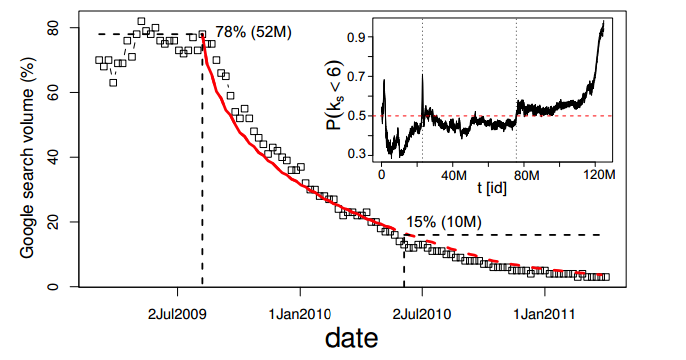When Social Networks Collapse
Social media is a core part of most people’s web use, and while sites like Facebook and Twitter have found some stability in the last few years, many other social media sites have failed or collapsed. One example of a collapsed site is Friendster, an early precursor to MySpace and Facebook. In 2009, Friendster’s traffic rapidly plummeted as users left it in favor of these other sites. To analyze why this occurred, a 2013 study compared user data from Friendster to other more resilient social media sites and found several factors that can precipitate and protect against a sudden exodus of this nature.
What causes an exodus of users?
It was found, unsurprisingly, that people tend to leave a social network when its benefits no longer surpass the costs (i.e. time and effort) required to use it. The benefits in this case are the direct-benefit effects we have discussed in class: the intrinsic value to be found in being part of a crowd. The more effective a social network can be in connecting you to other people, the greater the benefit it delivers. However, if the site is slow, buggy or difficult to use, these costs can outweigh the benefits and you might abandon the site for a better one. It turns out that the precise point at which this imbalance induces a cascade of departures depends on the pattern of ties between people in the network itself.
The resilience of a social network
How likely a given user is to stay on a social network is directly related to the number of friends they have there. If you have only one friend on a social media site, there is not much to prevent you from abandoning that site for one that provides a better experience. Conversely, if your entire group of friends is on the site, the direct-benefit effects of staying are greater, and you are less likely to leave. The resilience of a site as a whole depends on the fraction of people in the latter category, specified as those who have at least 10 friends on the site. This fraction is termed a k-core distribution; sites with a lower k-core distribution are more vulnerable, while those with a higher k-core distribution are more resilient. If a site has both a low k-core distribution and high costs of use, the combination of these factors can lead to a cascade of abandonment.
Implications for the future of social media sites
One inference that can be drawn from these findings has to do with what enables new social media sites to succeed. For a new site—such as the emergent Facebook competitor Ello—to take root, a certain proportion of its adopters will have to be larger groups of friends, not just individuals. (As of this writing, Ello is wisely promoting this with its invite-only policy.) Another interesting implication is that a site’s resilience is not necessarily dependent on its overall popularity. For example, if a site has a relatively small number of users but its k-core distribution is high, it will be less likely to collapse the way Friendster did, even if few people in the world know and use it. A final, slightly depressing conclusion one can draw is that very large, highly-connected sites like Facebook have less incentive to improve. Its users may complain about their experiences, but due to the sheer number of connections they have on the site and the benefits of having a profile there, the majority of them are not going anywhere.
Sources:
http://www.technologyreview.com/view/511846/an-autopsy-of-a-dead-social-network/
http://arxiv.org/abs/1302.6109

